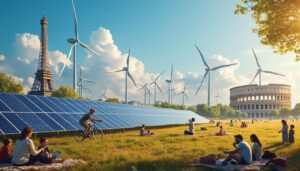In 2025, Australia is at a crossroads, with ambitious promises and bold forecasts painting a complex picture of successes and setbacks. The country had envisioned significant changes such as an Australian republic, supermarkets operating at 100% renewable energy, and fully recyclable packaging solutions. However, some of these ambitions have materialized, while others still require considerable effort. The transition to renewable energy, which notably includes the progress of major retailers like Coles and Woolworths towards green electricity, shows significant advancement. Furthermore, initiatives such as replacing Australia Post motorcycles with electric delivery vehicles demonstrate a commitment to reducing the carbon footprint. However, challenges remain, such as the project for an Australian republic still out of reach and the sustainable packaging targets that remain incomplete. Looking at the goals for 2025, there is a mix of important achievements and unfulfilled promises that invite reflection on the future of Australia.
In 2025, Australia finds itself evaluating its promises, goals, and forecasts made years ago. Among these projects, the removal of Australia Post motorcycles is on track, with a replacement by safer and more efficient electric vehicles. However, the idea of an Australian republic remains on hold, despite stated intentions a decade ago.
On the recyclable packaging front, the country is unlikely to meet its ambitious targets, due to a lack of thriving markets for recycled products. On the other hand, supermarkets Coles and Woolworths are positively moving towards the exclusive use of renewable energy sources by 2025.
The gender parity among Labor MPs made possible this year contrasts with the ambitious expansion of the national broadband network, which seems to be on track. In contrast, promises of reduced energy bills have not materialized, with costs even rising due to the global energy crisis.

account of ambitions and realities for Australia
In 2025, Australia reaches a turning point where some promises and forecasts materialize while others fall by the wayside. One of the major projects, the transition to an Australian republic, has stumbled upon insurmountable political obstacles. Ten years after Bill Shorten’s ambitious declaration, this project remains sidelined. The initial enthusiasm has lost momentum following the death of the queen in 2022, throwing the country back into a debate between republicanism and constitutional monarchy. Numerous factors, including the lack of political consensus and the failure of the referendum on the Indigenous voice in 2023, have hindered this advancement towards significant constitutional change.
environmental advances and setbacks
While some environmental commitments have borne fruit, others have not achieved the expected results. One of the ambitious goals, making packaging 100% recyclable, remains out of reach according to a recent review. The pressure to improve recycling and reduce plastic waste has been hampered by a lack of infrastructure and markets for recycled products. Conversely, the transition of supermarkets like Coles and Woolworths to 100% renewable energy is well underway. Their shift to renewable electricity sources by the end of the year represents a notable technological advancement that boosts the clean energy market.
renewable energy and broken promises
The renewable energy sector in Australia is experiencing an unprecedented acceleration, even though some promises have not been fulfilled. The forecast to reduce electricity bills by $275 by 2025 remains an unkept promise, as, on the contrary, costs have risen. Analysts attribute this increase to the volatility of the fossil fuel market, exacerbated by geopolitical tensions such as the war in Ukraine. Nevertheless, the electrification of vehicle fleets, notably by Australia Post which is gradually replacing its gasoline motorcycles with electric vehicles, proves the public sector’s commitment to sustainable solutions despite the unexpected challenges. South Australia proudly showcases 75% of energy from wind and solar, an inspiring example for the rest of the country. This success demonstrates a strong commitment to renewable energy sources but also highlights the disparity in progress across various initiatives.
Articles similaires
Thank you!
We will contact you soon.














